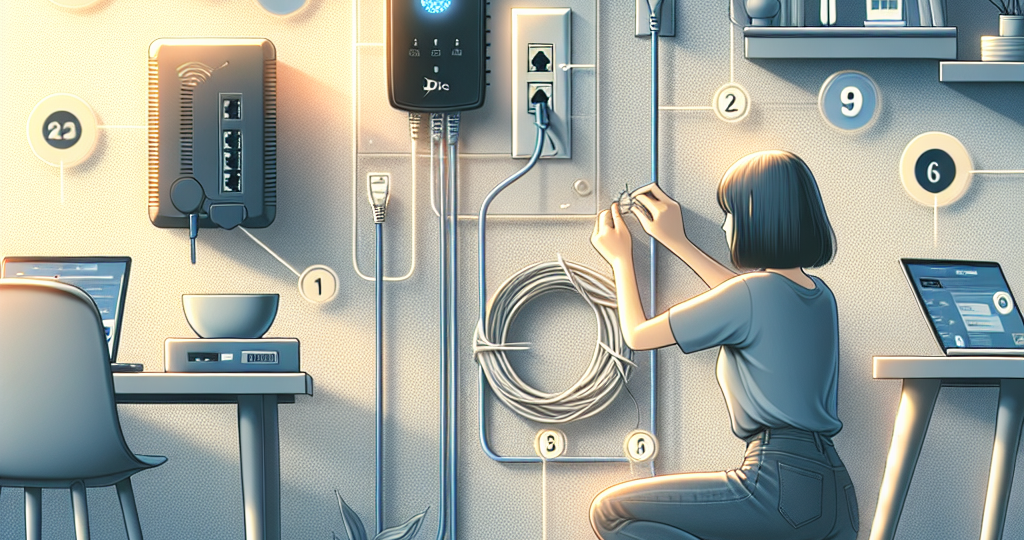
In this guide, we will explore essential tips for setting up cable internet at home to ensure a seamless and efficient connection. Whether you are a tech-savvy individual or a complete beginner, this step-by-step process will walk you through everything you need to know to get your home network up and running in no time. From choosing the right equipment to troubleshooting common issues, this comprehensive guide will empower you to set up your cable internet with ease. Say goodbye to slow and unreliable connections – follow these tips and enjoy lightning-fast internet speeds from the comfort of your own home!
Understanding Cable Internet Basics

Cable internet is a type of high-speed internet connection that utilizes the same coaxial cable lines that deliver cable television. It offers faster speeds and more reliable connections compared to traditional dial-up or DSL internet.
What is cable internet?
- Cable internet is a broadband connection that uses a cable modem and a coaxial cable to connect to the internet service provider’s network.
- It provides internet access through the same cable lines that deliver cable television signals.
- Cable internet offers higher speeds and more consistent performance compared to older connection types like dial-up.
How does cable internet work?
- Cable internet works by transmitting data through coaxial cables that are connected to a cable modem in the user’s home.
- The cable modem modulates and demodulates signals to facilitate data transmission between the user’s devices and the internet service provider’s network.
- The data travels through the cable lines to reach the provider’s infrastructure, allowing users to access the internet at high speeds.
Benefits of choosing cable internet for your home
- Cable internet offers faster download and upload speeds, making it ideal for activities like streaming, gaming, and video conferencing.
- It provides a more stable connection compared to wireless options like satellite internet.
- Cable internet is widely available in urban and suburban areas, making it accessible to a large number of households.
- Users can bundle cable internet with other services like television and phone to save on monthly costs and simplify billing.
Differentiating Cable Internet from Other Types
- Contrasting cable internet with DSL and fiber-optic internet
When comparing cable internet with DSL (Digital Subscriber Line) and fiber-optic internet, it’s essential to understand the underlying technology that powers each type. Cable internet operates using the same coaxial cables that deliver cable television, providing high-speed internet access through a broadband connection. On the other hand, DSL utilizes telephone lines to transmit data, offering a more stable connection compared to traditional dial-up internet. Fiber-optic internet, the fastest of the three, uses fiber-optic cables to transmit data using light signals, resulting in unparalleled speeds and reliability.
- Factors to consider when choosing cable internet
When deciding on the type of internet service for your home, several factors come into play. Speed is a crucial consideration, with cable internet typically offering faster speeds than DSL but lagging behind fiber-optic internet. Cost is another significant factor, as cable internet is often more affordable than fiber-optic options but may be pricier than DSL services. Additionally, availability plays a vital role, as not all areas may have access to cable internet, especially in rural or remote locations. Lastly, consider the reliability and customer service reputation of the internet service provider, as a reliable connection and responsive support can make a significant difference in your internet experience.

Preparing Your Home for Cable Internet Installation
Checking for availability in your area
Before setting up cable internet at home, it is crucial to determine if cable internet services are available in your area. You can do this by checking with local cable internet providers or using online tools to verify service coverage. Availability may vary depending on your location, so it is essential to confirm before proceeding with the installation process.
Contacting cable internet providers for service setup
Once you have confirmed the availability of cable internet in your area, the next step is to contact cable internet providers to initiate the service setup. You can reach out to the providers via phone, online chat, or in-person at their local office. During this process, you will need to provide your address, contact information, and possibly schedule an installation appointment for a technician to set up the service at your home.
Understanding equipment requirements for cable internet
To set up cable internet at home, you will need specific equipment provided by the cable internet provider. This typically includes a modem, which connects to the cable outlet in your home, and a router, which distributes the internet connection wirelessly to your devices. Some providers may offer a modem-router combo device for convenience. It is essential to understand the equipment requirements and ensure compatibility with your home setup before proceeding with the installation process.
Setting Up Your Modem and Router
When setting up your cable internet at home, the initial step involves installing and connecting the modem. The modem serves as the gateway between your home network and the internet service provider. To begin, locate a central area in your home for the modem to ensure optimal signal strength throughout the premises. Connect the coaxial cable from the wall outlet to the modem’s input port, and then plug in the power adapter to a nearby electrical outlet.
After successfully installing the modem, the next crucial step is configuring your router for optimal performance. Connect an Ethernet cable from the modem to the router’s WAN port to establish a connection. Access the router’s settings by entering the default IP address in a web browser and logging in with the provided credentials. Configure the wireless network settings, such as network name (SSID) and password, to ensure a secure connection for all devices. Additionally, adjust the channel settings to minimize interference and maximize signal strength.
To enhance the security of your network, it is essential to secure it with a strong password. Choose a unique and complex password that includes a combination of letters, numbers, and special characters to prevent unauthorized access. Regularly update the password and enable encryption protocols like WPA2 to safeguard your network from potential threats. By following these steps, you can effectively set up your modem and router for a reliable cable internet connection at home.
Optimizing Your Home Network for Speed and Reliability
When setting up cable internet at home, it’s essential to optimize your home network for both speed and reliability. Here are some key tips to ensure you get the most out of your connection:
- Placement of the Modem and Router:
- Position the modem and router in a central location in your home to maximize signal strength and coverage.
- Avoid placing them near large appliances, metal objects, or walls that can interfere with the signal.
-
Elevate the devices to reduce interference from obstructions like furniture or other electronics.
-
Using Ethernet Connections:
- For devices that require high-speed and stable connections, such as gaming consoles or desktop computers, consider using Ethernet cables instead of relying solely on Wi-Fi.
-
Directly connecting devices to the router via Ethernet can significantly improve speed and reduce latency, especially for data-intensive activities like streaming or online gaming.
-
Setting Up a Guest Network:
- To enhance security and network performance, create a separate guest network for visitors to use when they visit your home.
- By setting up a guest network, you can prevent guests from accessing sensitive information on your primary network while still providing them with internet access.
- Guest networks also help distribute bandwidth more efficiently, ensuring that your primary devices receive priority when it comes to internet speed and stability.
Troubleshooting Common Cable Internet Issues
When setting up cable internet at home, users may encounter various connectivity issues. It is essential to be equipped with troubleshooting skills to address these common problems effectively. Below are some common cable internet issues and potential solutions:
Identifying Connectivity Problems and Potential Solutions
-
Intermittent Connection: If you experience sporadic internet connectivity, check the physical connections of your modem and router. Ensure all cables are securely plugged in. Additionally, consider resetting both devices to establish a stable connection.
-
No Internet Access: If you cannot access the internet despite a seemingly active connection, restart your modem and router. Verify that your service provider does not have any outages in your area. If the issue persists, contact your ISP for further assistance.
Dealing with Slow Internet Speeds
-
Check for Interference: Slow internet speeds may result from signal interference. Keep electronic devices away from your modem and router to minimize interference. Additionally, ensure your devices are not downloading or streaming content that consumes bandwidth.
-
Update Firmware: Outdated firmware on your modem or router can also contribute to slow internet speeds. Check for firmware updates on the manufacturer’s website and install them to optimize performance.
Contacting Technical Support for Advanced Troubleshooting
- When to Seek Help: If basic troubleshooting steps do not resolve your cable internet issues, it may be time to contact technical support. Your ISP’s customer service team can provide advanced troubleshooting assistance and guide you through more complex solutions.

– Provide Detailed Information: When reaching out to technical support, be prepared to provide detailed information about your setup and the specific issues you are facing. This information will help the support team diagnose the problem more efficiently and offer tailored solutions.
Enhancing Security and Privacy on Your Network
-
Enabling firewall protection on your router: One crucial step in securing your cable internet connection is to enable the firewall protection feature on your router. This acts as a barrier between your network and potential cyber threats, filtering out malicious traffic and unauthorized access attempts. By activating the firewall, you add an extra layer of defense to safeguard your personal information and devices connected to the network.
-
Updating firmware regularly for security patches: Keeping your router’s firmware up to date is essential for maintaining the security of your cable internet connection. Manufacturers often release firmware updates that address identified vulnerabilities and strengthen the overall protection of the device. By regularly checking for and applying these updates, you ensure that your router is equipped with the latest security patches to thwart potential cyber attacks and intrusions.
-
Using VPNs for secure browsing on public networks: When accessing your cable internet connection from public Wi-Fi networks, such as in cafes or airports, utilizing a Virtual Private Network (VPN) can enhance your security and privacy. A VPN encrypts your internet traffic, making it more challenging for hackers to intercept sensitive data or monitor your online activities. By establishing a secure connection to a remote server, VPNs create a private tunnel for your data to travel through, shielding it from prying eyes and potential threats.
Managing Data Usage and Monitoring Your Network
Enhancing Security and Privacy on Your Network
Internet service providers often impose data caps and usage limits on cable internet plans, which can impact your browsing experience and potentially lead to extra charges. To effectively manage your data usage and monitor your network, consider the following tips:
-
Understanding data caps and usage limits: Before setting up your cable internet at home, familiarize yourself with the data cap or usage limit associated with your plan. This information is typically outlined in the terms of service provided by your ISP. Knowing these limitations can help you avoid overages and optimize your internet usage.
-
Utilizing built-in tools to monitor network activity: Many modern routers come equipped with built-in tools that allow you to monitor the devices connected to your network and track their data usage. By accessing your router’s settings or using a companion app, you can easily identify which devices are consuming the most bandwidth and take steps to manage their usage accordingly.
-
Implementing parental controls for safer browsing: If you have children or want to restrict access to certain websites on your network, consider implementing parental controls. Most routers offer the ability to set up filters and restrictions based on device or user, allowing you to create a safer browsing environment for your family members. By setting up parental controls, you can also monitor the online activities of children and ensure they are browsing the internet responsibly.
Future-Proofing Your Home Network for Evolving Needs
In today’s fast-paced digital landscape, it is crucial to future-proof your home network to keep up with evolving needs. By following these tips, you can ensure that your cable internet setup remains reliable and efficient for years to come.
Upgrading to Newer Cable Internet Technologies
- Consider upgrading to DOCSIS 3.1: Upgrading to a DOCSIS 3.1 modem can offer faster speeds and improved reliability compared to older DOCSIS 3.0 models. This can future-proof your network by ensuring compatibility with newer cable internet technologies.
- Invest in a high-quality router: A modern, high-performance router can make a significant difference in your internet speeds and overall network stability. Look for a router that supports the latest Wi-Fi standards, such as Wi-Fi 6, to accommodate the increasing number of connected devices in your home.
- Opt for a mesh Wi-Fi system: If you have a large home or experience Wi-Fi dead zones, a mesh Wi-Fi system can provide seamless coverage throughout your space. This can future-proof your network by adapting to changes in your home’s layout or the addition of new devices.
Exploring Options for Smart Home Integration
- Choose smart home-compatible devices: When setting up your cable internet, consider investing in smart home devices that are compatible with your network. This can include smart thermostats, security cameras, lighting systems, and voice assistants. Integrating these devices into your network can enhance your home’s efficiency and convenience.
- Set up a separate guest network: To accommodate smart home devices and guests’ devices, consider setting up a separate guest network. This can help to protect your main network from potential security risks while allowing guests to access the internet seamlessly.
Staying Informed About Advancements in Cable Internet Services
- Follow industry news and updates: Stay informed about advancements in cable internet services by following industry news, attending webinars, or subscribing to newsletters from your internet service provider. Being aware of new technologies and service offerings can help you make informed decisions about upgrading your network.
- Regularly assess your internet needs: Periodically assess your internet usage and needs to ensure that your current plan meets your requirements. As technology evolves and your usage patterns change, you may need to upgrade your plan to accommodate higher speeds or data limits.
FAQs Tips for Setting Up Cable Internet at Home
What is cable internet and how does it work?
Cable internet is a type of high-speed internet connection that utilizes the same coaxial cables that are used for cable television. The cables transmit data to and from your home through a cable modem, which connects to the internet service provider’s network. This allows for faster and more reliable internet connections compared to traditional dial-up or DSL services.
What equipment do I need to set up cable internet at home?
To set up cable internet at home, you will need a cable modem provided by your internet service provider. You will also need a Wi-Fi router to create a wireless network in your home. Additionally, you may need an Ethernet cable to connect the modem to the router, and any necessary cables to connect your devices to the router.
How do I set up my cable internet connection?
To set up your cable internet connection, start by connecting the cable modem to a cable outlet in your home using a coaxial cable. Then, connect the modem to your Wi-Fi router using an Ethernet cable. Plug in the modem and router, and follow the provided instructions to activate your internet service. Finally, connect your devices to the Wi-Fi network and you should be ready to go.
Are there any tips for optimizing my cable internet connection?
To optimize your cable internet connection, consider the placement of your router for the best coverage and signal strength throughout your home. You can also try adjusting the channel settings on your router to minimize interference from other devices. Additionally, make sure to keep your modem and router up to date with the latest firmware updates provided by the manufacturer.
How Utility Panels Bring in Cable and Internet to Your House
RELATED POSTS
View all

